
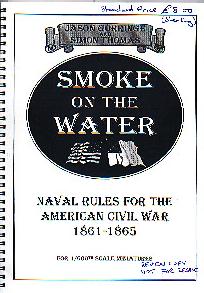
| |
These rules cover riverine and coastal naval combat during the American Civil War. The intent is to provide authentic outcomes and period flavour, without sacrificing playability. Rules include simultaneous movement (using written orders), ramming, current, anchoring, running aground, gunnery, boarding actions, morale, repair, torpedoes, forts and batteries. Optional rules add drifting, rate of fire, and towing. Stats are provided for 47 classes of ships. Design rules allow players to determine game stats for any vessel for which they have sufficient historical data. Booklet includes bibliography and 1:600 scale model listing.Turning templates and markers are provided at the back of the booklet, to be photocopied, mounted on cardstock, and cut out for use. 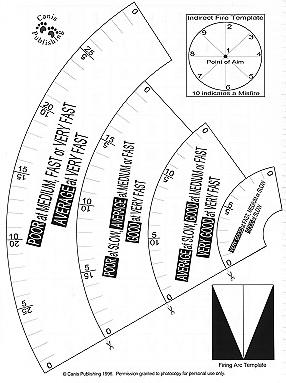
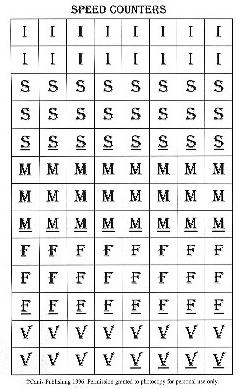 |
|---|---|
| Period | American Civil War - Naval Combat |
| Scale | Tactical. Ground scale is 1 mm = 2 feet, 5 cm = 1 knot of speed. Time scale is 1 turn = 1 minute. Ships are represented individually. Designed for 1:600 scale ships, but supplementary sheet provides adjustments for 1:1200 scale. |
| Basing | Individual. Models are placed on bases, with marks to aid in determining field of fire and target aspect.  |
| Contents | 62-page spiral-bound rulebook, three reference cards,
one supplementary sheet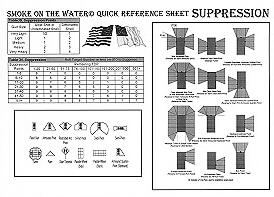
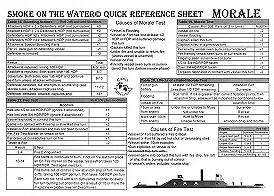
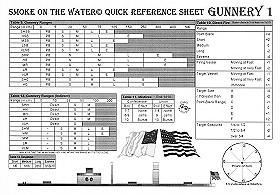 |
| Designers | Jason Gorringe, Simon Thomas |
| Publisher | First edition published 1996 by Canis Publishing |
A detailed description of the game is also available.
| Kevin Rolfs (krolfs@austin.inri.com) |
|---|
The game is interesting, but has a few weaknesses that need more work. Such as:
Otherwise, the game does allow simplification of speed and armor to static values that make book-keeping fairly simple. The fort rules are fairly neat, with suppression being a factor. Large engagements (of over 12 vessels) takes a lot of time until conclusion because of the gun-combat rules. Smaller battles work fine. Modifying the rules so that armor weakens or penetration occurs more from Double or Triple Powdering - or even allowing greater chance at Point-Blank Range - would speed up vessel damage, and allow more vessels in an engagement for shorter battles (given real-time constraints). |
| George A. Koncar (gkoncar@laca.org) |
| I played SOTW for the first time at a convention. I was very impressed with how easy it plays. It was a very enjoyable game. |
| Ray Garbee (Garbee@aol.com) |
| I've been a fanatical convert to Smoke on the Water since the first edition
appeared in 1996. Prior to SotW, we had been gaming with a variety of
ACW naval rules, none of which left us entirely happy.
The game is technically excellent - superb mechanics, good layout and clearly written. The database suffers from some odd errors (and not just on Confederate ships). Pilot house armor on the Cairo should be better than light. Easy enough to fix. Especially as I have to revise the Cairo class stats for any battle beyond 1862. The game could stand some sort of an 'opportunity fire' mechanic, but beyond that I'm very happy with the system. Our ongoing campaign continues to yield exciting games and moments of sheer tragedy. My last game witnessed a record three magazine explosions, as well as some really lethal rams. Overall, I give SotW a rating of 9 out of 10. Well done! |
| Willie Bogaerts (willie@glo.be) |
We've been playing SOTW regularly for about a year and a half now, using the exellent Thoroughbred models in 1/600th scale. So far absolutely the best rules for Ironclad wargaming we've been able to find. And they only got better when we started to use the alternative ramming rules found on the Canis webpage. The only problem I could find that was that some of the ship's statistics (especially armour factors) are not entirely correct, and that the differences within a certain class (e.g., Passaic class) are not mentioned. Of course this has nothing to do with the game mechanics, which are as said, excellent,and with a little research, easy to correct. |
| Chuck Duggie (minadmiral@aol.com) |
Don`t criticize ACW naval rules too heavily about ship stats. Lot of this is lost data, especially CSN. Ships were planned and "designed" but the builder, and the individual naval officer in charge, frequently made changes. Often major changes. And that is not even allowing for non availability of materials. Or the substitution of sub standard material because the proper material was just not available. Remember, also, the Confederacy was handicapped more and more as the war went on by the non availability of railroads to transport men and material because some Silly Old Boy had ripped up the rails to use as ship armor (inferior), or to melt down as raw material. |
If you would like to add your opinion to this webpage, use the following form or send email to the editor.
If you know of other resources for this game, please let us know by sending email to the editor. If you have material you would like to make available to the Net, also let us know.
| Last Updates | |
|---|---|
| 14 October 2004 | updated link |
| 16 August 1999 | comments by Kevin Rolfs |
| 6 May 1999 | comments by George A. Koncar |
| 19 April 1999 | comments by Ray Garbee |
| 31 July 1998 | comments by Willie and Chuck |
| Comments or corrections? | |